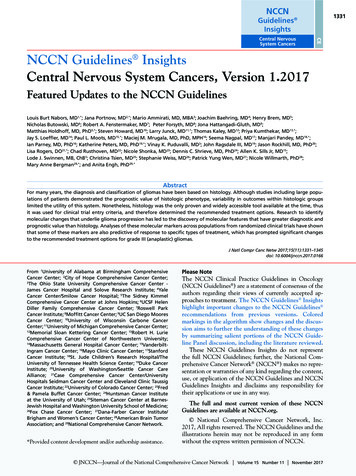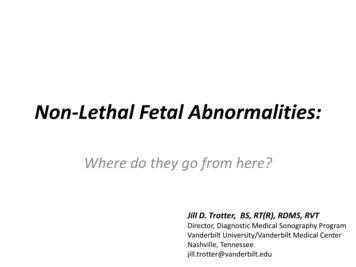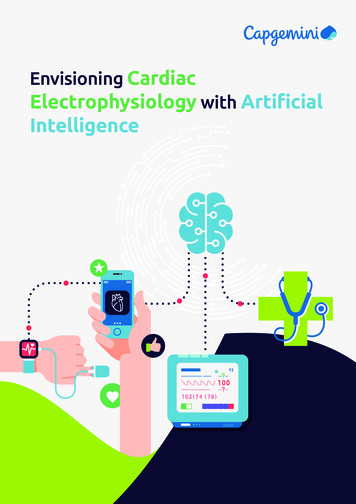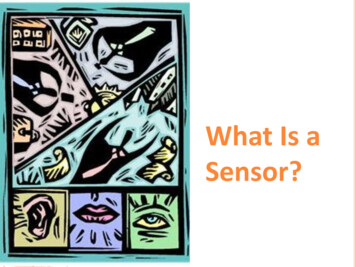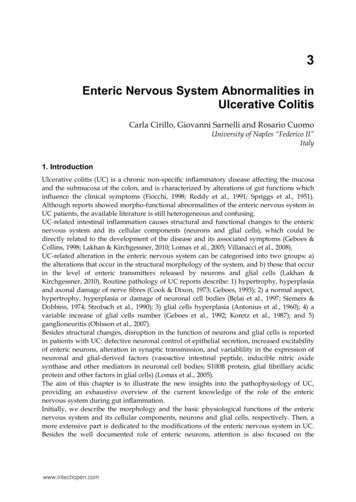
Transcription
3Enteric Nervous System Abnormalities inUlcerative ColitisCarla Cirillo, Giovanni Sarnelli and Rosario CuomoUniversity of Naples “Federico II”Italy1. IntroductionUlcerative colitis (UC) is a chronic non-specific inflammatory disease affecting the mucosaand the submucosa of the colon, and is characterized by alterations of gut functions whichinfluence the clinical symptoms (Fiocchi, 1998; Reddy et al., 1991; Spriggs et al., 1951).Although reports showed morpho-functional abnormalities of the enteric nervous system inUC patients, the available literature is still heterogeneous and confusing.UC-related intestinal inflammation causes structural and functional changes to the entericnervous system and its cellular components (neurons and glial cells), which could bedirectly related to the development of the disease and its associated symptoms (Geboes &Collins, 1998; Lakhan & Kirchgessner, 2010; Lomax et al., 2005; Villanacci et al., 2008).UC-related alteration in the enteric nervous system can be categorised into two groups: a)the alterations that occur in the structural morphology of the system, and b) those that occurin the level of enteric transmitters released by neurons and glial cells (Lakhan &Kirchgessner, 2010). Routine pathology of UC reports describe: 1) hypertrophy, hyperplasiaand axonal damage of nerve fibres (Cook & Dixon, 1973; Geboes, 1993); 2) a normal aspect,hypertrophy, hyperplasia or damage of neuronal cell bodies (Belai et al., 1997; Siemers &Dobbins, 1974; Strobach et al., 1990); 3) glial cells hyperplasia (Antonius et al., 1960); 4) avariable increase of glial cells number (Geboes et al., 1992; Koretz et al., 1987); and 5)ganglioneuritis (Ohlsson et al., 2007).Besides structural changes, disruption in the function of neurons and glial cells is reportedin patients with UC: defective neuronal control of epithelial secretion, increased excitabilityof enteric neurons, alteration in synaptic transmission, and variablility in the expression ofneuronal and glial-derived factors (vasoactive intestinal peptide, inducible nitric oxidesynthase and other mediators in neuronal cell bodies; S100B protein, glial fibrillary acidicprotein and other factors in glial cells) (Lomax et al., 2005).The aim of this chapter is to illustrate the new insights into the pathophysiology of UC,providing an exhaustive overview of the current knowledge of the role of the entericnervous system during gut inflammation.Initially, we describe the morphology and the basic physiological functions of the entericnervous system and its cellular components, neurons and glial cells, respectively. Then, amore extensive part is dedicated to the modifications of the enteric nervous system in UC.Besides the well documented role of enteric neurons, attention is also focused on thewww.intechopen.com
30Ulcerative Colitis – Epidemiology, Pathogenesis and Complicationsinvolvement of glial network in the complex scenario of intestinal inflammation, on whichthere is accumulating evidence in recent years. Finally, the implication of the entericnervous system in the control of the gut immune system during inflammation is describedin the last part of the chapter, as recently hypothesized.2. The Enteric Nervous System: Morphological and functional featuresThe Enteric nervous System (ENS) is a collection of neurons in the gastrointestinal (GI) tract,and constitutes the “brain in the gut”, since it has the unique ability to control several GIfunctions, such as exocrine and endocrine secretions, motility, blood flow andimmune/inflammatory processes, independent of the central nervous system (Goyal &Hirano, 1996). In the ENS, the nerve-cell bodies are grouped into small ganglia that areconnected by nerve bundles forming two major layers embedded in the gut wall, themyenteric plexus (or Auerbach’s plexus) and the submucosal plexus (or Meissner’s plexus)(Goyal & Hirano, 1996). The myenteric plexus lies between the longitudinal and circularmuscle and extends the entire length of the gut. This layer primarily provides motorinnervations to the two muscle layers, and secretomotor innervations to the mucosa. Thesubmucosal plexus, located between the mucosa and circular muscle (Furness & Costa 1980;Grundy et al., 2006), is best developed in the small intestine, where it plays an importantrole in the control of secretion. Both these components contain functionally differentneurons (about 100 millions) and four to ten times more glial cells, together organized inganglia (Goyal & Hirano, 1996; Hoff et al., 2008). Neurons and glial cells of the ENS arederived from stem cells in the neuronal crest, a transient structure present during embryonicdevelopment (Dupin et al., 2006).2.1 Enteric neuronsAlthough up to eight morphologic forms of neurons have been identified in the ENS, thereare two main types: type I neurons, that have many club-shaped processes and a single longprocess, and type II neurons, that are multipolar and have many long, smooth processes(Furness & Costa, 1980). Functionally, enteric neurons can be classified into primary afferentneurons, interneurons and motor neurons, synaptically linked to each other in microcircuits(Furness & Costa, 1980). Moreover, there is a general classification between neurons of thesubmucosal plexus and neurons of the myenteric plexus: while the first ones predominantlyinnervate the mucosa and regulate secretion, absorption and blood flow, the second ones areprimarily involved in the control of intestinal motility (Brookes, 2001). Enteric neurons arealso known to control mucosal development and function as well as some aspects of thelocal immune system within the gut. This fine regulation of several and different functionsis possible because enteric neurons are in close proximity to other cells present in the gutwall (mucosal immune cells and epithelial cells) and also secrete a wide range ofneurotransmitters.The chemical neuro-mediators of the ENS were initially thought to be limited toneurotransmitters such as acetylcholine and serotonin, but, subsequently, purines, such asATP, amino acids, such as -aminobutyric acid, and peptides, such as vasoactive intestinalpolypeptide (VIP) and neuropeptide Y (NPY), were identified (Gershon et al., 1994). Morerecently, nitric oxide (NO) has emerged as an important neurotransmitter in the ENS(Bogers et al., 1994). Overall, more than 20 candidate neurotransmitters have now beenwww.intechopen.com
Enteric Nervous System Abnormalities in Ulcerative Colitis31identified in enteric neurons, and most neurons contain several of them (Gershon et al.,1994). Distinctive patterns of co-localization of mediators appear to identify sets of neuronsthat perform distinct functions (Costa & Brookes, 1994; Gershon et al., 1994). Althoughneurotransmitter functions have been clearly defined for only a few of these mediators suchacetylcholine, substance P (SP), VIP, NPY and NO, it is well known that a wide variety ofneurons that perform different functions may use the same neurotransmitter.2.2 Enteric Glial Cells (EGC)Morphologically, EGC are small cells with a ‘star-like’ appearance (Hoff et al., 2008)containing intracellular arrays of 10 nm filaments made up of glial fibrillary acidic protein(GFAP) (Bjorklund et al., 1984; Endo & Kobayashi, 1987; Hoff et al., 2008; Mestres et al.,1992). These cells envelop enteric neuronal cell bodies and axon bundles (Gershon &Rothman, 1991), as well as intestinal blood vessels (Bjorklund et al., 1984; Geboes et al.,1992), and extend their processes into the intestinal mucosa (Bush et al., 1998; Jessen &Mirsky, 1980). Though, phenotypically comparable to the astrocytes in the central nervoussystem, EGC account for other similiar functions, such as the regulation of gut homeostasis,as well as inflammatory responses (Broussard et al., 1993; Gershon & Rothman, 1991). Sincetheir first description by Dogiel in 1899, EGC have been assumed to be the most abundantcell type in the ENS (Gabella, 1981). At present, the S100B protein and GFAP, together withmore recently identified markers such as Sox 10, are commonly used to identify EGC in thehuman gut (Bjorklund et al., 1984; Cirillo et al., 2009a; Esposito et al., 2007; Ferri et al., 1982;Hoff et al., 2008). Functionally, EGC have been traditionally considered as a mechanicalsupport for enteric neurons since they release a wide range of factors responsible for thedevelopment, survival and differentiation of peripheral neurons (Laranjeira & Pachnis,2009). Like their counterpart in the brain, EGC, in physiological conditions, constitutivelyexpress major histocompatibility complex (MHC) class I molecules, whereas MHC class IIexpression is sparsely detectable (Geboes et al., 1992; Koretz et al., 1987). In recent years, thisrestrictive view has been changed to one of a more articulate and complex nature, since EGCare involved in the maintenance of intestinal homeostasis (Bassotti et al., 2007; VanLandeghem et al., 2009). Indeed, these cells control intestinal epithelial barrier functions,such as permeability, via the release of GSNO (S-nitrosoglutathione) as well as theregulation of expression of zonulin-1 and occludin (Neunlist et al., 2008; Savidge et al.,2007a).Besides the well documented ‘protective role’, EGC are also activated by means ofinflammatory insults and they directly contribute to an inflammatory condition by antigenpresentation and by promoting the release of pro-inflammatory cytokines in the gut milieu,thus making them the initiators of immune responses (Cabarrocas, 2003; Cirillo et al., 2009a;Esposito et al., 2007; Neunlist et al., 2008; Savidge et al., 2007b). This ability of EGC to beatigen presenting cell is due to the expression of MHC class II molecule, in the presence ofpro-inflammatory stimuli, as recently demonstrated (Cirillo et al., 2009a). Therefore, EGC actas ‘receptors’ for cytokines and may themselves produce cytokines, such as interleukin-6and interleukin-1-beta (Murakami et al., 2009; Ruhl et al., 2001). In addition, EGC expressthe inducible form of nitric oxide synthase (iNOS) and L-arginine, the machinery requiredfor the time-delayed and micromolar release of nitric oxide (NO), one of the most importantpro-inflammatory mediators within the gut (Aoki et al., 1991; Cirillo et al., 2009b; Nagahamaet al., 2001).www.intechopen.com
32Ulcerative Colitis – Epidemiology, Pathogenesis and Complications2.2.1 EGC markers: GFAP and S100B proteinMature EGC are rich in the intermediate filament protein GFAP (Eng et al., 2000; Jessen &Mirsky, 1980). In animals, two classes of EGC can be distinguished, namely the GFAPpositive and GFAP negative groups and this ratio is under control of pro-inflammatorycytokines (von Boyen et al., 2004). GFAP expression is modulated by cell differentiation,inflammation and injury (Eng et al., 2000), indicating that the level of this filament matcheswith the functional state of EGC. Increased GFAP expression has been observed ininflammation or inflammatory diseases of the gut, such as UC (Bradley et al., 1997; Cornet etal., 2001).S100B is an easily diffusible protein that is a homodimer of subunit (Baudier et al., 1986). Itbelongs to the S100 protein family that includes more than 20 EF-hand Ca2 /Zn2 -bindingproteins (Haimoto et al., 1987; Sugimura et al., 1989; Zimmer & Van Eldik, 1987). In thehuman gut, among S100 proteins, only the S100B protein is specifically and physiologicallyexpressed by EGC (Cirillo et al., 2009a; Cirillo et al., 2009b; Esposito et al., 2007), while othermembers, such as S100A8, S100A9 and S100A12 are found in phagocytes and in intestinalepithelial cells in patients affected by inflammatory bowel disease (Leach et al., 2007;Pietzsch & Hoppmann, 2009). Recent findings have demonstrated that aberrant expressionof S100B correlates with the degree of the gut inflammation (Cirillo et al., 2009b; Esposito etal., 2007). The search for a specific S100B signalling receptor has demonstrated that, inmicromolar concentrations, this protein may accumulate at the RAGE (receptor foradvanced glycation endproducts) site on target cells, such as immune cells (Adami et al.,2004; Hofmann et al., 1999; Schmidt et al., 2001). Such interaction leads to the activation of asignalling cascade resulting in the transcription of different pro-inflammatory cytokines andiNOS protein. S100B can, thus, be considered as a diffusible pro-inflammatory cytokinewhich gains access to the extracellular space especially at immune-inflammatory reactionsites in the gut (Adami et al., 2001; Cirillo et al., 2009a; Cirillo et al., 2009b; Esposito et al.,2007; Petrova et al., 2000).3. Role of enteric neurons in UCInflammation is well known to affect gut functions, since it leads to persistent changes inenteric nerves thus resulting in dismotility, hypersensitivity and dysfunction. Data obtainedfrom intestinal biopsies from UC patients, or on animal models of UC, have consistentlysuggested a role of neuro-inflammation in the generation of symptoms associated with thedisease (Beyak & Vanner, 2005; Geboes & Collins, 1998). Neuronal abnormalities stronglyillustrate the impact of inflammatory signals generated within the gut mucosa on the ENS.In this context, the neuronal regeneration represents a challenging concept and studiesaiming to the identification of progenitor-like cells in the ENS are crucial (Kruger et al.,2002).3.1 Structural changesTo understand the relationship between the intestinal inflammation that characterizes UCand structural abnormalities to the enteric neurons, animal models of colitis are routinelyused. This enables us to elucidate the mechanisms underlying gut dysfuctions, which wouldbe rather difficult to observe in humans. The most commonly used models to induce colitisare characterized by intracolonic administration of 1) trinitrobenzene sulfonic acid (TNBS)www.intechopen.com
Enteric Nervous System Abnormalities in Ulcerative Colitis33or 2) 2,4-dinitrobenzene-sulfonic acid (DNBS) or 3) Trichinella spiralis (T. Spiralis) infection inthe animal.In guinea pigs, it has been described that the number of myenteric neurons per ganglion issignificantly decreased in TNBS-induced colitis (Linden et al., 2005). In this experimentalmodel, the observed decrease in myenteric neurons was not associated with a decrease inany particular subpopulation of neurons, suggesting a severe loss of neurons that occurduring the onset of colitis. In addition, the neurotoxic insult is followed by a rapidregeneration of the axons from the surviving neurons. These data are confirmed in a ratmodel of TNBS-induced colitis, in which there is a significant loss of myenteric neurons as aresult of an increased rate of apoptosis (Sarnelli et al., 2009). Similar changes are reported inanother model of chemically-induced colitis in rats, with DNBS administration, which ischaracterized by a significant decrease of neuronal cells in the myenteric plexus of the ENS(Sanovic et al., 1999; Hawkins et al., 1997). As confirmed by histopathological assessment, inthis model, compared to the TNBS-induced model, the neuronal damages are more similarto those observed in UC patients. Significant neuronal death is also observed in T. spiralisinduced colitis in mice and rats (Auli et al., 2008). Intracolonic administration of T. spiralislarvae in rats causes colitis with features similar to UC, notably with inflammationpredominantly limited to the colonic mucosa (Auli et al., 2008). Interestingly, in this animalmodel of colitis, the authors also provide information about the subpopulation of neuronsaffected by inflammation, describing that there is a significant decrease especially in thenumber of nitric oxide synthase (NOS)-immunoreactive neurons in the myenteric plexus ofinfected rats, with consequent changes in intestinal motility.In humans, abnormalities of the neuronal components of the ENS reported in UC patientsinclude hyperplasia or increased number of neuronal cell bodies, mainly in the ganglia ofthe submucosal plexus, neuronal cell damage, and neuronal hypertrophy. In addition,hypertrophy of the neuronal cell bodies in the submucosal plexus seems to be common inUC patients (Mottet, 1971; Van Patter et al., 1954). Neuronal hyperplasia of the myentericplexus is also reported for UC but the data available in the literature is rare and may havebeen complicated by difficulties in the differential diagnosis between granulomatous colitisand genuine UC (Okamoto, 1964; Storsteen et al., 1953). Neuronal cell hyperplasia iscertainly more frequently reported for Crohn’s disease and seems more common with asignificant, statistical difference when compared with UC. In addition to hypertrophy andhyperplasia of neuronal cell bodies, signs of degeneration have been described occasionallyin areas of the inflamed gut in UC patients (Oehmichen & Reiffersscheid, 1977; Rienmann &Schmidt, 1982).Also neuronal synapses appear to be altered in patients with UC. This is because of anincreased synaptophysin (a synaptic vesicle protein involved in synapse formation butwithout a well defined functional role) immunoreactivity, compared to samples fromnormal mucosa and from cases with non-specific colitis, in which mucosal fibres are rareand usually small (Strobach et al., 1990). Submucosal and myenteric nerve fibre hypertrophyis uncommon in UC patients. Ultra-structural studies of UC and control samples haveshown that, in both submucosal and myenteric layers, the nerve fibres or axons appear asswollen, empty, lucent structures, with large membrane-bound vacuoles, swollenmitochondria and concentrated neurofibrils (Dvorak et al., 1980). These changes can be focalor diffuse and can affect all axons in one nerve bundle or just few of them. This datasupports the hypothesis of a correlation between the neural hyperplasia and thewww.intechopen.com
34Ulcerative Colitis – Epidemiology, Pathogenesis and Complicationsinflammatory reaction in UC patients. It appears, thus, that UC is characterized by twotypes of structural neuronal abnormalities: damage and hyperplasia of neurons in all partsof the ENS, related to inflammation.Changes in the chemical coding of myenteric neurons are described in UC patients (Neunlistet al., 2003). Immunohistochemical characterization of neurons in the myenteric plexusrevealed that alterations occur in the proportion of choline acetyltransferase(ChAT)/negative (-ve), ChAT/SP-ve, and SP-ve populations in UC patients compared to theintestinal tissues from control subjects. These changes have similar features in inflamed andnon-inflamed areas of the gut in UC patients. The use of a combination of antibodies againstChAT, VIP and SP enabled the identification of transmitter co-localisation in colonicmyenteric neurons, showing five distinct subpopulations (ChAT-ve, ChAT/SP-ve,ChAT/VIP-ve, VIP-ve, and SP-ve). The largest neuronal population identified in themyenteric plexus of UC patients is ChAT immunoreactive and hence of cholinergic nature.VIP formed 9% of the total neuronal population. Most of the SP ve neurons co-localize withChAT. In UC patients, there is a threefold increase in the proportion of myenteric neuronsimmunoreactive for SP, compared to control subjects, whereas the proportion of ChAT veand VIP ve neurons was not affected. The increase in SP observed in the inflamed gut ofUC patients is a hallmark of the disease pathology. Moreover, an increase in the density ofSP immunoreactive fibres and SP content in UC patients, especially in the lamina propriahas been reported (Goldin et al., 1989; Keranen et al., 1995; Vento et al., 2001). At present, nodata are available to address the questions of whether the changes in SP observed inmyenteric neurons of UC patients are the result of transductional, post-transductional, oreven alterations in peptide transport. In this context, changes in mRNA levels for SPreceptors are observed in UC patients (Goede et al., 2000) but it is not known whether SPmRNA is increased in myenteric neurons or whether degradation of SP is altered in thisinflammatory disease. The increase in SP ve neurons observed in UC patients occursprimarily in the population of ChAT-ve neurons detected in control subjects. In fact, thetotal proportion of ChAT ve neurons is not modified in UC patients compared with controlsubjects, and the increase in the proportion of ChAT/SP-ve neurons is equivalent to thedecrease in the proportion of the ChAT-ve population observed in UC patients. What mightbe the clinical relevance of the SP increase in UC? Firstly, SP may play an important role inthe pathophysiology of UC (Holzer, 1998). In fact, there is increased expression of SPbinding sites in UC as well as an increase in neurokinin 1 (NK-1) receptor mRNA (Goede etal., 2000; Mantyh et al., 1995). Confirming the involvement of NK-1 in the modulation of gutinflammation, in an animal model of colitis, the administration of NK-1 antagonist reducedcolonic inflammation (Stucchi et al., 2000). In the same animal model, inflammation inducedan increase in SP synthesis in myenteric neurons. Moreover, a decrease in neutralendopeptidase activity (the enzyme which degrades SP) was observed in T. spiralis-infectedintestine in conjunction with increased SP levels (Hwang et al., 1993). These combinedeffects result in an increased SP levels and down-regulation of endopeptidase activity,which could significantly increase SP that might contribute to uncontrolled intestinalinflammation in UC. A surprising finding is that alterations in the neurochemical code ofmyenteric neurons occur in similar proportions in inflamed and non-inflamed areas of UCpatients, as mentioned above. SP induction during UC in non-inflamed and inflamed areascould be due to an increase in inflammatory cytokines such as interleukin-1beta, which havewww.intechopen.com
Enteric Nervous System Abnormalities in Ulcerative Colitis35been observed during UC in the intestine (Fiocchi, 1998). In fact, interleukin-1beta inducesincreased SP expression in rat myenteric fibres (Hurst et al., 1993). In summary, markedchanges in the neurochemical coding of myenteric neurons characterize UC. ChAT-veneurons can be considered as the putative neuronal population exhibiting neural plasticityby expressing different levels of SP. Therefore, this remodelling in UC occurs as a shift frommainly cholinergic to more peptidergic innervation. Similar changes in neurochemicalcoding were also observed in the least affected sites of inflammation. This effect mayconstitute part of the neuronal basis for the altered motility observed during UC.Another important neuropeptide, calcitonin gene-related peptide (CGRP), is involved ininflammatory processes and is regulated by nerve growth factor (NGF) (Linsday & Harmar,1989). In inflammatory bowel disease, NGF and its high affinity receptor (trkA) are highlyover-expressed in the inflamed tissues (Di Mola et al., 2000). Studies have shown thatneuropeptides, like CGRP (Reinshagen et al., 1998), are protective in acute (Reinshagen etal., 1994) and chronic (Reinshagen et al., 1996) models of experimental colitis. As a result, theprotective effect of neurotrophic factors can partly be explained by a specific modulation ofneuropeptide expression during inflammation. Therefore, in an experimental model ofinflammation of the rat gut, NGF and neurotrophin-3 seem to have a protective effect. Whenthese neurotrophic factors are experimentally and selectively blocked during colitis, thisleads to a significant increase in inflammation (Reinshagen et al., 2000).3.2 Functional changesAbnormalities of the enteric neurons during the course of inflammation leads to alteredintestinal functions. Three major groups of functional neuronal changes are observed in UCpatients: 1) defects in the neuronal control of epithelial secretion, 2) increased excitability ofenteric neurons and 3) alteration in synaptic transmission (Lomax et al., 2005). Due to theirlocalization within the intestine, changes in enteric neurons reflect in the alterations of abroad range of functions that are orchestrated by the other cell types (epithelial, immune,endocrine cells) residing the gut wall. Specifically, the five primary targets of the entericneurons are 1) smooth muscle cells responsible for motility; 2) mucosal secretory cells; 3)endocrine cells; 4) the microvasculature that maintains mucosal blood flow during intestinalsecretion and 5) the immunomodulatory and inflammatory cells that are involved inmucosal immunologic, allergic and inflammatory responses (Goyal & Hirano, 1996).A number of electrophysiological studies have been performed in animal models of colitis inorder to elucidate the mechanisms underlying inflammation-induced changes in entericneuronal functions in UC patients (Lakhan & Kirchgessner, 2010). Independent of themethod used to induce colitis, the type of enteric neurons most dramatically affected byinflammation is the after-hyperpolarizing (AH) neurons. The AH neurons physiologicallywork as intrinsic primary afferent neurons in the myenteric plexus and control intestinalperistalsis, mucosal secretion and vasodilatation. While in normal conditions these neuronsvery rarely receive fast synaptic inputs, in course of inflammation more AH neurons receivefast synaptic inputs, exhibit increased excitability, depolarized membrane potential, reducedAH potential amplitude and duration along with increased input resistance (Lennon et al.,1991; Yoshida et al., 1988). AH neurons characteristically receive slow excitatorypostsynaptic potentials in the normal non inflamed intestine, but increased excitation (longterm hyperexcitability) occurs in AH neurons during the course of inflammation (Qualmanet al., 1984). This pathological phenomenon indicates that a brief synaptic activation canwww.intechopen.com
36Ulcerative Colitis – Epidemiology, Pathogenesis and Complicationstrigger a long period of hyperexcitability in AH neurons after they have been exposed to aninflamed environment, thus suggesting that perturbation of the sensory component ofintrinsic motor reflexes may occur during inflammation and that increased neuronalexcitation may contribute to the altered motility, pain and discomfort associated withintestinal inflammation in UC patients. The mechanisms responsible for the changes inexcitability are not yet understood, but it is postulated that they involve a persistentalteration in channel expression and/or a continuous release of inflammatory mediators inthe intestinal milieu.Together with neuronal hyperexcitability, alterations in sympathetic neural activity, withconsequent impact on the functions of the ENS, are reported in UC patients (May & Goyal,1994). In animal models of colitis, the decrease in the release of noradrenaline fromsympathetic varicosities due to inhibition of N-type voltage-gated Ca2 current inpostganglionic sympathetic neurons, has been reported in both inflamed and un-inflamedregions of the gut (Ikeda et al., 1982). However, at present, how an alteration of sympatheticfunction contributes to the pathogenesis of UC has not yet been fully understood.As described above, UC is also characterized by nerve fibre hypertrophy and hyperplasia,but it is not clear whether these alterations have functional consequences or whichfunctional changes they might induce in the inflamed gut of UC patients. Some of the fibreswith a prominent appearance on routinely stained slides may indeed not be functional. Theswollen aspect of the axons observed with ultra structural studies might correspond withthe thickened appearance of the fibres reported in some immunohistochemical studies whilein fact these fibres are damaged and hence not functional.4. Role of Enteric Glial Cells in UCIt is widely known that EGC display many morphological and functional similarities withastrocytes in the brain, which are essential to maintain homeostasis in the central nervoussystem. Emerging reports indicate a regulatory role of EGC in the gut (Bassotti et al., 2007;Neunlist et al., 2008; Van Landeghem et al., 2009). From in vivo studies, we now know thatthe selective ablation of the glial network, carried out by using chemical methods, leading tointestinal inflammation that is associated with the alteration of mucosal barrier integrity(Bush et al., 1998; Savidge et al., 2007). Moreover, animal models in which the ablation ofEGCs was auto-immune mediated, demonstrated that these cells are also capable of immunefunctions in vivo (Cornet et al., 2001). Additional studies have demonstrated that EGCdirectly affect intestinal epithelial barrier integrity via the release of factors such astransforming growth factor-beta, S-nitrosogluthatione and glial-derived neurotrophic factor(GDNF) (Neunlist et al., 2007; Savidge et al., 2007; von Boyen et al., 2011), thus confirmingthe crucial role played by EGC in the regulation of gut homeostasis. Given the ability ofEGC to modulate the intestinal barrier functions and to mediate immune responses in vivo, ithas also been claimed that these cells are involved in inflammatory bowel disease (Cirillo etal., 2009b; Cornet et al., 2001; Neunlist et al., 2007; Neunlist et al., 2008). Several studies haveunderlined the involvement of EGC in intestinal inflammation during which both mucosaland motor functions are altered (Cirillo et al., 2009b; Cornet et al., 2001; Sethi & Sarna, 1991).Indeed, changes in EGC architecture, together with impaired expression of EGC-derivedfactors, are reported in UC patients. Among the glial-derived mediators, GFAP, S100Bprotein and GDNF are up-regulated in UC patients (Cirillo et al., 2009; Cornet et al., 2001;Steinkamp et al., 2003; von Boyen et al., 2011).www.intechopen.com
Enteric Nervous System Abnormalities in Ulcerative Colitis37Confirming the involvement of EGC in the intestinal inflammatory scenario,immunohistochemical studies also revealed an increase in MHC class II membranousexpression on EGC and glial sheaths of nerve fibres in
Ulcerative colitis (UC) is a chronic non-specific inflammatory disease affecting the mucosa and the submucosa of the colon, and is charac terized by alterations of gut functions which influence the clinical symptoms (Fiocchi, 1998; Reddy et al., 1991; Spriggs et al., 1951).



